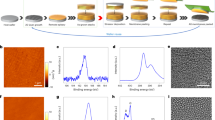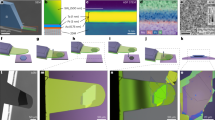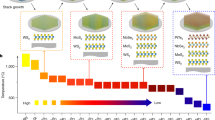Abstract
High-performance semiconductor films with vertical compositions that are designed to atomic-scale precision provide the foundation for modern integrated circuitry and novel materials discovery1,2,3. One approach to realizing such films is sequential layer-by-layer assembly, whereby atomically thin two-dimensional building blocks are vertically stacked, and held together by van der Waals interactions4,5,6. With this approach, graphene and transition-metal dichalcogenides—which represent one- and three-atom-thick two-dimensional building blocks, respectively—have been used to realize previously inaccessible heterostructures with interesting physical properties7,8,9,10,11. However, no large-scale assembly method exists at present that maintains the intrinsic properties of these two-dimensional building blocks while producing pristine interlayer interfaces12,13,14,15, thus limiting the layer-by-layer assembly method to small-scale proof-of-concept demonstrations. Here we report the generation of wafer-scale semiconductor films with a very high level of spatial uniformity and pristine interfaces. The vertical composition and properties of these films are designed at the atomic scale using layer-by-layer assembly of two-dimensional building blocks under vacuum. We fabricate several large-scale, high-quality heterostructure films and devices, including superlattice films with vertical compositions designed layer-by-layer, batch-fabricated tunnel device arrays with resistances that can be tuned over four orders of magnitude, band-engineered heterostructure tunnel diodes, and millimetre-scale ultrathin membranes and windows. The stacked films are detachable, suspendable and compatible with water or plastic surfaces, which will enable their integration with advanced optical and mechanical systems.
This is a preview of subscription content, access via your institution
Access options
Access Nature and 54 other Nature Portfolio journals
Get Nature+, our best-value online-access subscription
$29.99 / 30 days
cancel any time
Subscribe to this journal
Receive 51 print issues and online access
$199.00 per year
only $3.90 per issue
Buy this article
- Purchase on Springer Link
- Instant access to full article PDF
Prices may be subject to local taxes which are calculated during checkout




Similar content being viewed by others
Change history
21 November 2017
In the HTML version of the Figure 2 legend, the AFM height image was corrected from '2 mm × 2 mm' to '2 μm × 2 μm'.
References
Sedra, A. S. & Smith, K. C. Microelectronic Circuits 2nd edn, 791–801 (Holt, Rinehart and Winston, 1982)
Nakamura, S. et al. InGaN-based multi-quantum-well-structure laser diodes. Jpn. J. Appl. Phys. 35, L74–L76 (1996)
Faist, J. et al. Quantum cascade laser. Science 264, 553–556 (1994)
Geim, A. K. & Grigorieva, I. V. van der Waals heterostructures. Nature 499, 419–425 (2013)
Liu, Y. et al. van der Waals heterostructures and devices. Nat. Rev. Mater. 1, 16042 (2016)
Novoselov, K. S., Mishchenko, A., Carvalho, A. & Castro Neto, A. H. 2D materials and van der Waals heterostructures. Science 353, aac9439 (2016)
Wang, L. et al. One-dimensional electrical contact to a two-dimensional material. Science 342, 614–617 (2013)
Xu, W. et al. Correlated fluorescence blinking in two-dimensional semiconductor heterostructures. Nature 541, 62–67 (2016)
Hunt, B. et al. Massive Dirac fermions and Hofstadter butterfly in a van der Waals heterostructure. Science 340, 1427–1430 (2013)
Rivera, P. et al. Valley-polarized exciton dynamics in a 2D semiconductor heterostructure. Science 351, 688–691 (2016)
Kim, C.-J. et al. Chiral atomically thin films. Nat. Nanotechnol. 11, 520–524 (2016)
Haigh, S. J. et al. Cross-sectional imaging of individual layers and buried interfaces of graphene-based heterostructures and superlattices. Nat. Mater. 11, 764–767 (2012)
Lee, Y. G. et al. Quantitative analysis of hysteretic reactions at the interface of graphene and SiO2 using the short pulse I–V method. Carbon 60, 453–460 (2013)
Kretinin, A. V. et al. Electronic properties of graphene encapsulated with different two-dimensional atomic crystals. Nano Lett. 14, 3270–3276 (2014)
Chiu, M.-H. et al. Spectroscopic signature for interlayer coupling in MoS2-WSe2 van der Waals stacking. ACS Nano 8, 9649–9656 (2014)
Liu, K. et al. Evolution of interlayer coupling in twisted molybdenum disulfide bilayers. Nat. Commun. 5, 4966 (2014)
Kim, D. H. et al. Stretchable and foldable silicon integrated circuits. Science 320, 507–511 (2008)
Jang, H. et al. Quantum confinement effects in transferrable silicon nanomembranes and their applications on unusual substrates. Nano Lett. 13, 5600–5607 (2013)
Li, B. et al. Scalable transfer of suspended two-dimensional single crystals. Nano Lett. 15, 5089–5097 (2015)
Kang, K. et al. High-mobility three-atom-thick semiconducting films with wafer-scale homogeneity. Nature 520, 656–660 (2015)
Huang, B. et al. Layer-dependent ferromagnetism in a van der Waals crystal down to the monolayer limit. Nature 546, 270–273 (2017)
Yun, W. S., Han, S. W., Hong, S. C., Kim, I. G. & Lee, J. D. Thickness and strain effects on electronic structures of transition metal dichalcogenides: 2H-MX2 semiconductors (M = Mo, W; X = S, Se, Te). Phys. Rev. B 85, 033305 (2012)
Britnell, L. et al. Electron tunneling through ultrathin boron nitride crystalline barriers. Nano Lett. 12, 1707–1710 (2012)
Simmons, J. G. Generalized formula for the electric tunnel effect between similar electrodes separated by a thin insulating film. J. Appl. Phys. 34, 1793–1803 (1963)
Kang, J., Tongay, S., Zhou, J., Li, J. & Wu, J. Band offsets and heterostructures of two-dimensional semiconductors. Appl. Phys. Lett. 102, 012111 (2013)
Maraghechi, P., Foroughi-Abari, A., Cadien, K. & Elezzabi, A. Y. Enhanced rectifying response from metal-insulator-insulator-metal junctions. Appl. Phys. Lett. 99, 253503 (2011)
Baek, S. H. et al. Giant piezoelectricity on Si for hyperactive MEMS. Science 334, 958–961 (2011)
Feng, J. et al. Single-layer MoS2 nanopores as nanopower generators. Nature 536, 197–200 (2016)
Gurarslan, A. et al. Surface-energy-assisted perfect transfer of centimeter-scale monolayer and few-layer MoS2 films onto arbitrary substrates. ACS Nano 8, 11522–11528 (2014)
Xi, X. et al. Strongly enhanced charge-density-wave order in monolayer NbSe2 . Nat. Nanotechnol. 10, 765–769 (2015)
Acknowledgements
We thank D. Talapin, P. L. McEuen and M. Guimaraes for discussions and for helping with preparing the manuscript. This work was mainly supported by the Air Force Office of Scientific Research (FA9550-16-1-0031, FA2386-13-1-4118) and the Nano Material Technology Development Program through the National Research Foundation of Korea funded by the Ministry of Science, ICT, and Future Planning (2012M3A7B4049887). Additional funding was provided by the National Science Foundation (NSF) through the Platform for the Accelerated Realization, Analysis, and Discovery of Interface Materials (PARADIM; DMR-1539918) and the Cornell Center for Materials Research (CCMR; NSF DMR-1120296). Material characterizations including electron microscopy were supported by the CCMR (NSF DMR-1120296) and the MRSEC Shared User Facilities at the University of Chicago (NSF DMR-1420709). Device fabrication and characterizations were performed at the Cornell Nanoscale Facility (Grant ECCS-1542081) and the Pritzker Nanofabrication Facility of the Institute for Molecular Engineering at the University of Chicago (NSF NNCI-1542205), both of which are members of the National Nanotechnology Coordinated Infrastructure supported by the National Science Foundation.
Author information
Authors and Affiliations
Contributions
K.K. and K.-H.L. contributed equally to this work. K.K., K.-H.L. and J.P. conceived the experiments. K.K., H.G. and S.X. synthesized the monolayer TMD films. K.K., K.-H.L. and H.G. developed the PVS method. Y.H. and D.A.M. conducted the atomic-resolution STEM imaging and FIB milling. K.-H.L. fabricated and measured the tunnelling devices. K.K. and K.-H.L. performed the AFM, XRD and optical measurements. K.K., K.-H.L. and J.P. wrote the manuscript. All authors discussed the results and commented on the manuscript.
Corresponding author
Ethics declarations
Competing interests
The authors declare no competing financial interests.
Additional information
Publisher's note: Springer Nature remains neutral with regard to jurisdictional claims in published maps and institutional affiliations.
Supplementary information
Supplementary Information
This file contains Supplementary Methods, Supplementary Notes, Supplementary Table 1, Supplementary Tables 1-13 and Supplementary References. The Supplementary Methods contain a detailed description of preparation, characterization and applications of our samples, the Supplementary Notes contains additional characterization data supporting the large-scale uniformity, pristine interlayer interfaces and interlayer coupling of our stacked TMD films and additional description of our experimental observation, tunnel model and statistical method. Supplementary Table contains a list of combined characterizations and their length scales and the Supplementary Figures contains additional characterization data and schematics of our process. (PDF 2010 kb)
Mechanical peeling of a 2-inch ML MoS2 film with TRT/PMMA from its growth substrate
A video of mechanical peeling of a 2-inch ML MoS2 film with TRT/PMMA from its growth substrate (SiO2/Si in our experiment). (MP4 1101 kb)
Delamination process of a ML MoS2 film from the substrate by dipping it into water with no polymer support or chemical treatment
A video of delamination process of a ML MoS2 film from the substrate by dipping it into water with no polymer support or chemical treatment. (MP4 722 kb)
Rights and permissions
About this article
Cite this article
Kang, K., Lee, KH., Han, Y. et al. Layer-by-layer assembly of two-dimensional materials into wafer-scale heterostructures. Nature 550, 229–233 (2017). https://doi.org/10.1038/nature23905
Received:
Accepted:
Published:
Issue Date:
DOI: https://doi.org/10.1038/nature23905
This article is cited by
-
Van der Waals enabled formation and integration of ultrathin high-κ dielectrics on 2D semiconductors
npj 2D Materials and Applications (2024)
-
Fabrication of angstrom-scale two-dimensional channels for mass transport
Nature Protocols (2024)
-
Molecule-based vertical transistor via intermolecular charge transport through π-π stacking
Nano Research (2024)
-
Stack growth of wafer-scale van der Waals superconductor heterostructures
Nature (2023)
-
Free-electron interactions with van der Waals heterostructures: a source of focused X-ray radiation
Light: Science & Applications (2023)
Comments
By submitting a comment you agree to abide by our Terms and Community Guidelines. If you find something abusive or that does not comply with our terms or guidelines please flag it as inappropriate.



